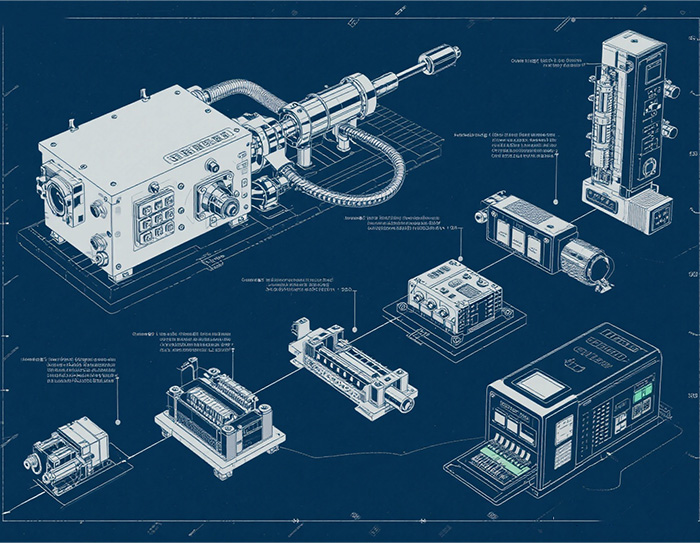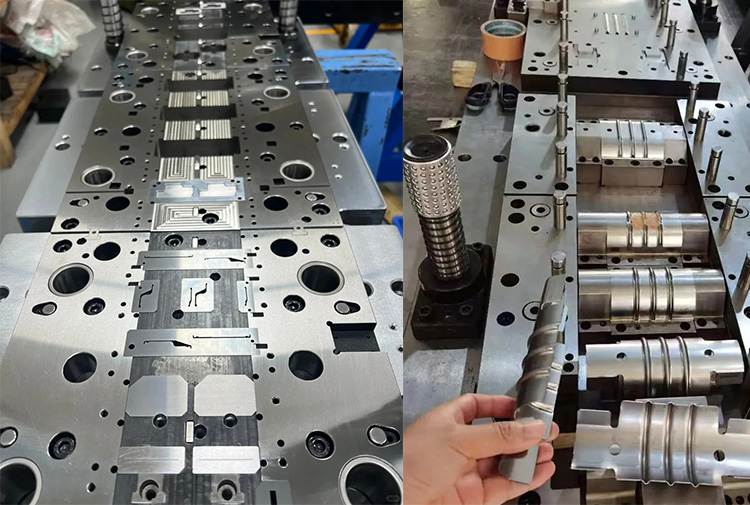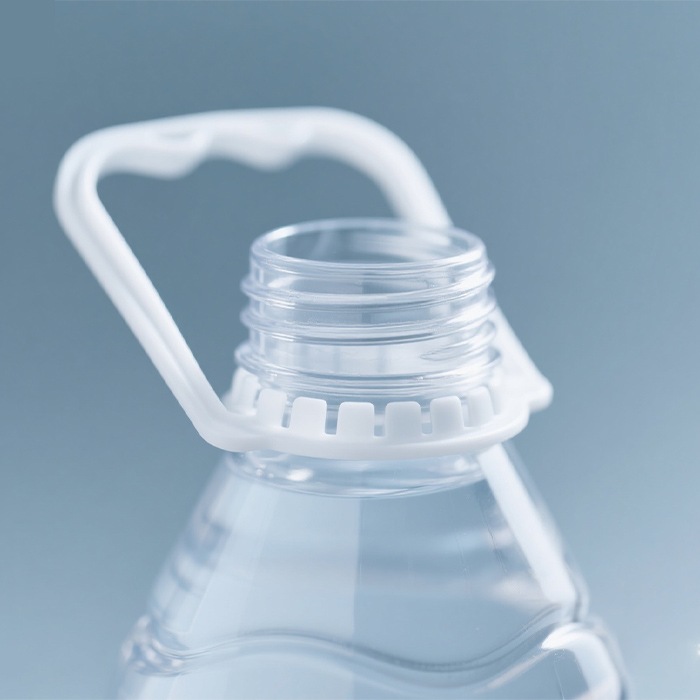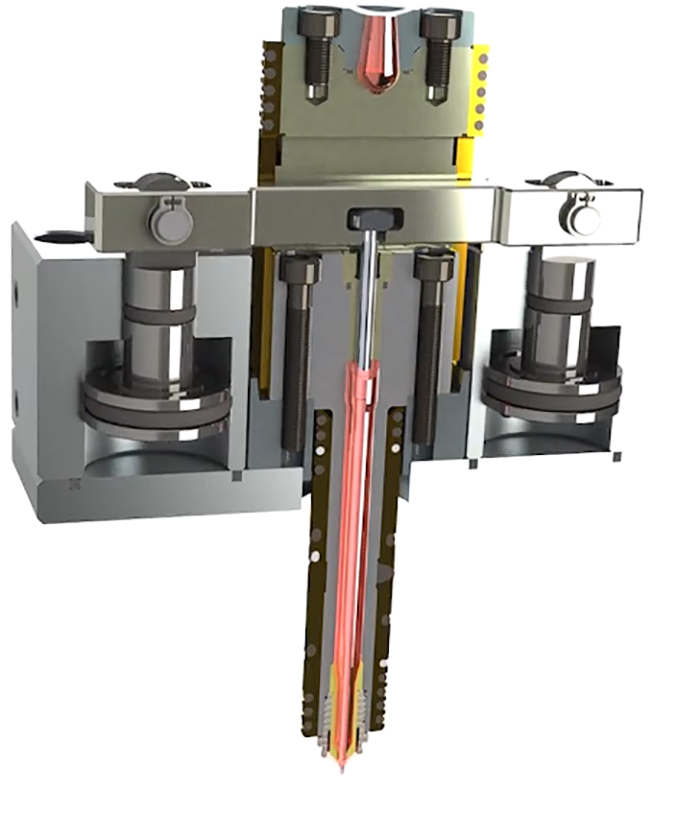IntroductionThe hot runner temperature controller is an essential component in modern injection mold...
How Does an Injection Molding Machine Work? :A Step-by-Step Guide for You
Injection molding is a manufacturing process in which molten plastic is injected into a metal mold to form parts. First, plastic pellets are melted and injected under high pressure; the polymer then cools and solidifies in the mold cavity. This method enables mass production of complex plastic parts with high dimensional accuracy. A typical injection molding machine has two main units – an injection unit (melts and injects the plastic) and a clamping unit (holds and opens/closes the mold)
Composition of an Injection Molding Machine
A standard injection molding machine is composed of three main systems:
Injection System、Mold Clamping System、Hydraulic Control System
Injection System
Function:
The injection system is responsible for plasticizing a set amount of plastic and injecting it into the mold cavity with adequate pressure and speed. It also maintains holding pressure after injection to compensate for material shrinkage during cooling.
Key Components:
Plasticizing unit: Includes the nozzle, barrel, and screw for melting and mixing the plastic.
Hopper: Feeds raw material into the barrel; often equipped with a drying device to remove moisture from the plastic pellets.
Screw drive system: Transmits power to the screw for rotation and axial movement.
The Plastic Injection Molding Process
Plastic injection molding is a cyclic manufacturing process. Each complete cycle results in the production of one molded part and consists of the following key steps:
Quantitative Feeding – Plastic pellets are fed into the injection molding machine in a measured amount.
Melt Plasticization – The plastic is heated and melted by the rotating screw inside the barrel.
Pressure Injection – The molten plastic is injected into the mold cavity under high pressure.
Mold Filling and Cooling – The mold is filled, and the plastic cools and solidifies into the shape of the cavity.
Mold Opening and Part Ejection – The mold opens, and the finished plastic part is ejected.
After part removal, the mold closes, and the next cycle begins.
In every cycle, both the injection unit and the clamping unit of the injection molding machine operate in coordination. Each unit completes one working cycle, with their respective moving parts acting in a predetermined sequence to ensure efficient and consistent production.
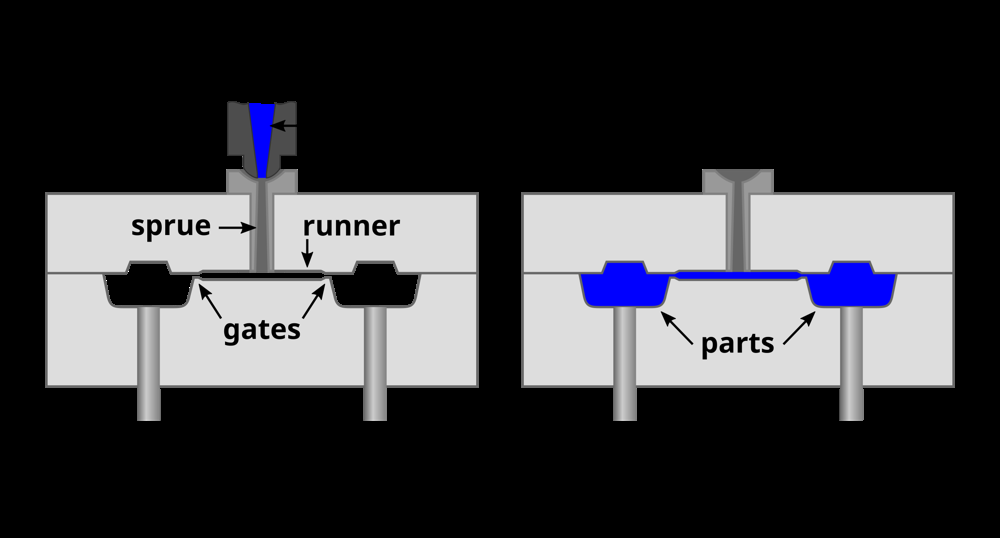
Injection Molding Process Stages
1. Plasticization Stage
Plastic raw materials (usually in pellet form) are fed from the hopper into the barrel of the injection molding machine. Inside the barrel:
The rotating screw conveys the material forward.
The plastic is heated externally by barrel heaters and internally through:
Compression from the decreasing volume of the screw grooves.
Shear and friction generated by the screw’s rotation, which causes intense mixing and frictional heat between the plastic particles, the screw, and the barrel.
As the material melts, it gradually forms a homogeneous molten polymer. Due to back pressure at the screw tip, the screw gradually retreats while continuing to rotate, allowing the molten plastic to accumulate in front of the screw. The screw retraction stroke corresponds to the amount of molten material needed for one injection cycle.
2. Injection Stage
Once plasticization is complete and the screw stops rotating:
The clamping mechanism engages to close the mold securely.
The injection unit advances, positioning the nozzle tightly against the sprue bushing of the mold.
The injection piston or screw then moves forward at high speed and pressure, injecting the molten plastic into the mold cavity.
·
After the cavity is filled:
The machine enters the pressure holding (packing) phase, where pressure is maintained to compensate for material shrinkage during cooling.
Holding continues until the gate solidifies, preventing backflow and ensuring part accuracy.
3. Shaping and Ejection Stage
After holding pressure ends:
The molten plastic in the cavity cools and solidifies, transitioning from a viscous flow state to a rigid, glassy state.
Once sufficiently cooled:
The clamping unit opens the mold.
The ejection system pushes the molded part out of the cavity, completing the cycle.
The mold then closes again, and the next injection molding cycle begins.
2. Mold Clamping System
Function:
The mold clamping system serves to open and close the mold, eject finished parts, and apply sufficient clamping force to resist injection pressure, preventing mold separation or material leakage.
Performance Requirements:
Clamping Force: Must be strong enough to prevent mold separation or flash formation during high-pressure injection.
Sufficient Mold Space: The template area, opening stroke, and tie-bar spacing must accommodate molds for various part sizes.
Speed Control:
Mold closing: Should be fast initially, then slow near closing to avoid mold collision.
Mold opening: Typically follows a slow-fast-slow sequence for controlled demolding.
Structural Strength: Templates and mechanical parts must withstand repeated stress to ensure dimensional stability and machine longevity.
Key Components:
Clamping mechanism
Mold height adjustment mechanism
Ejection mechanism
Front and rear fixed templates
Moving template
Tie bars
Hydraulic cylinders
Injection unit: Drives the screw forward to inject molten plastic.
Injection seat and moving cylinders: Adjust the position of the injection unit and connect it with the mold sprue.
3. Hydraulic Control System
Function:
The hydraulic system provides the power and control needed to drive both the injection and clamping systems.
Main Subsystems:
Power System: Provides hydraulic energy through motors and pump units.
Execution System: Includes hydraulic cylinders and hydraulic motors that drive mechanical movement.
Control System: Directs the flow and pressure of hydraulic oil using valves and sensors to ensure precise control.
Auxiliary System: Supports cooling, filtration, and safety features.
Hydraulic Medium: The hydraulic oil acts as the energy transmission medium throughout the system.
How to Choose an Injection Molding Machine Reasonably
Selecting the right injection molding machine is essential for achieving product quality, production efficiency, and cost-effectiveness. The selection process generally involves the following key steps:
1. Choose the Appropriate Machine Model
Start by identifying the general type and tonnage of the injection molding machine based on:
The size and geometry of the product
The material being used
The mold design
Production volume requirements
Machine models vary by clamping force, injection capacity, and structural configurations (e.g., hydraulic vs. all-electric).
2. Check Mold Compatibility
Ensure the injection molding machine is physically capable of housing the mold by verifying:
Tie-bar spacing: The distance between tie-bars must accommodate the mold width and height.
Mold thickness range: The machine must support the mold’s minimum and maximum thickness.
Minimum mold size: The mold’s base dimensions should match or exceed the machine’s required minimum.
Platen size: Ensure the fixed and moving platens are large enough to support the mold base safely and securely.
3. Verify Mold Opening and Ejection Capabilities
Based on the mold design and the finished product:
Mold opening stroke must be long enough to allow full separation of the mold halves and removal of the part.
Ejection stroke must be sufficient to completely eject the part without damage or sticking.
4. Calculate the Required Injection Volume
Use the weight of the finished product and number of cavities to determine the total shot size needed.
Choose a screw diameter that provides an injection volume 20–80% of the machine’s rated shot capacity for optimal control and plasticization.
Ensure the barrel capacity is not too small (causing insufficient filling) or too large (resulting in material degradation due to long residence time).
5. Consider Plastic Material Requirements
Different plastic materials have different processing needs. Select machine features accordingly:
Screw compression ratio: Must match the material's viscosity and melting behavior. For example:
Low compression for PVC, flame-retardant plastics
Medium to high compression for PP, PE, PS
Injection pressure: Must be sufficient to fill complex molds or thin-walled parts.
Plasticizing capacity: Ensure the screw and barrel design can deliver proper melting and mixing efficiency.
Commonly Used Injection Molding Machine Brands
Austria
ENGEL
A global leader in injection molding technology, known for its innovative tie-bar-less machines, energy efficiency, and all-electric solutions.
Germany
Demag (Sumitomo Demag)
Renowned for precision, speed, and reliability, especially in high-performance applications like medical and packaging.
Battenfeld (Wittmann Battenfeld)
Offers a full range of hydraulic, hybrid, and all-electric machines, focusing on flexibility and integration with automation systems.
Italy
Sandretto (Synderdo/Sandretto)
One of Italy’s historical brands in injection molding, known for robust hydraulic machines and efforts toward modernization with hybrid models.
Japan
Toyo
A specialist in all-electric injection molding machines, offering high precision and energy efficiency.
Toshiba (now Shibaura Machine)
Known for durable and versatile machines, widely used across automotive and electronics industries.
Sodick (Sadick)
Focuses on high-precision, two-stage plunger-type electric injection molding machines, ideal for micro molding and high-end parts.
Fanuc
Offers fully electric machines known for ultra-high precision, reliability, and integration with CNC technology.
Sumitomo
A pioneer in all-electric technology, often paired with Demag in global branding (Sumitomo Demag), known for high-speed and high-precision molding.
Nissei
Offers a wide range of hydraulic, hybrid, and electric machines, suitable for both general-purpose and high-tech applications.
Nippon Steel
Less common today in standard injection molding machine manufacturing; more well-known in steel production and materials. Possibly refers to affiliated or legacy machinery in niche markets.
Hot Runner Temperature Controller Technical Considerations
Material Behavior: Plastics exhibit viscoelastic behavior. Melt viscosity is highly temperature-dependent. Higher melt temperatures dramatically reduce viscosity, improving flow into thin sections. However, excessively high melt temperature can degrade the polymer and lengthen cycle time (longer cooling). Conversely, if melt temperature is too low, flow may be incomplete (short shots) and internal stresses increase (more elastic behavior). Moisture-sensitive materials (like nylon) must be dried before molding to prevent defects. Fill pressure and speed must overcome shear forces; designers often consult viscosity or melt-flow tables for each resin.
Temperature Control: The barrel is divided into zones (feed, compression, metering), each with independent heaters and thermocouples. Typical polymer temperatures range from 180°C (for polyolefins) up to 300°C (for engineering plastics). Precise temperature control ensures consistent melt viscosity. The mold’s temperature (via coolant) also critically affects part quality: a hotter mold improves surface finish and reduces residual stress, while a colder mold reduces cooling time.
Injection and Clamp Pressure: The injection pressure must be high enough to fill the cavities quickly; typical values are tens to hundreds of MPa. After filling, a slightly lower holding pressure is maintained. The clamping force must counter the total cavity pressure acting on the projected area. Rule-of-thumb: Clamp Tonnage ≈ (Cavity Pressure) × (Projected Area) (often multiplied by a safety factor ~1.2–1.3). For example, a 500 cm² area at 300 kg/cm² cavity pressure requires roughly 200 tonnes of clamp force.
Cycle Time: The overall cycle time is the sum of plasticizing, injection, cooling, and ejection times. Cooling usually dominates. Minimizing cycle time involves faster cooling (e.g. baffles or conformal cooling channels), efficient melt production, and quick mold movement. However, cooling must be sufficient to avoid part warpage or deformation. Warpage can also be reduced by uniform cooling and by packing pressure adjustments.
Machining and Setup: Proper mold setup is crucial. This includes aligning the mold on the platens, ensuring nozzle-to-sprue alignment (often with a nozzle probe), and setting shot size. The machine’s shot size (screw position) is programmed slightly above the required part weight to ensure a melt cushion. Barrel and mold temperatures are set per material, and injection/hold speeds and pressures are tuned on a test run. Safety interlocks and guards must be in place around moving parts.
Maintenance: Regular maintenance includes cleaning the barrel and screw (to remove residue), inspecting heater bands, and greasing the toggle or hydraulic system. Resin purity and moisture content should be monitored. Worn screw tips or check rings can cause fluctuations in shot size and pressure.
Troubleshooting (Common Issues): Short shots (incomplete fill) often indicate low melt temperature, insufficient injection pressure/speed, or a too-small gate. Flash (excess plastic at parting line) suggests too much shot or insufficient clamp force. Warping can result from uneven cooling or high residual stresses; it can be mitigated by balanced filling, uniform cooling, or reducing packing pressure. Burn marks or degradation occur if plastic is overheated or trapped air overheats. Consistent monitoring of injection pressure and velocity curves can help detect anomalies during production.
FAQs
1. What is the purpose of the clamping unit in an injection molding machine?
The clamping unit holds the mold halves together during injection to withstand the high internal pressure of the molten plastic. It also opens and closes the mold for part ejection. A properly sized clamping force prevents defects like flash or mold separation.
2. How does the screw inside the injection unit work?
The screw rotates to convey, melt, and homogenize plastic pellets in the barrel. It has three zones—feed, compression, and metering—and generates pressure and frictional heat to plasticize the resin. After plasticizing, the screw moves forward to inject the molten plastic into the mold.
3. Why is precise temperature control important in injection molding?
Temperature directly affects melt viscosity, flow behavior, cycle time, and part quality. Barrel zones and the mold have independent temperature controls to ensure optimal flow, reduce shrinkage, and improve surface finish while minimizing warpage and internal stress.
4. What is the typical cycle time for plastic injection molding?
Cycle time varies by part size, material, and mold design, but typically ranges from 10 to 60 seconds. Cooling time is usually the longest phase, often making up 50–80% of the cycle.
